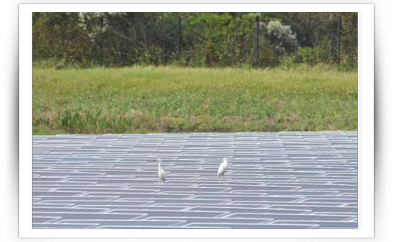| While the pressures of climate change bring a sense of urgency to renewable energy development, a new study serves as a roadmap toward uniting the goals of a low-carbon future with that of ecological sustainability and conservation.
The study, published in the journal Frontiers in Sustainability from the University of California, Davis, and John Hopkins University, aims to help decision-makers avoid the unintended environmental consequences of renewable energy development."Renewables aren't always sustainable, but they can be if we think proactively," said co-leading author Sarah Jordaan, an assistant professor at John Hopkins University's School of Advanced International Studies. "There is a huge misalignment between United Nations Sustainable Development Goals and climate goals. This is a call to action for leaders to come together to address it."
To develop the roadmap, the authors assessed public and private investments in renewable energy and analyzed the tradeoffs and synergies of clean energy. They also identified research themes drawn from a two-day workshop held by the Electric Power Research Institute in 2019 with 58 leading experts in the fields of renewable energy and sustainability from across academia, industry, government sectors.
MISSING THE FOREST FOR THE GHGs
Among the key research priorities identified for sustainable solar and wind developments include site selection and understanding interactions with wildlife.For example, Florida's longleaf pine forests have, for centuries, helped store carbon, protect water quality and provide wildlife habitat. Now, only a fraction of the historical range of longleaf pine forests in the state remain. Yet a sliver of that remaining sliver is slated to be replaced by a solar installation.
Meanwhile, in the same state and just a few miles away, water birds squawk, preen their feathers, and hunt for food atop a floating array of solar panels -- a "float voltaic" installation. Here, both wildlife and greenhouse-gas-reduction goals appear to coexist gracefully.
|
"We can't pursue climate change mitigation blindly," said co-leading author Rebecca. R. Hernandez, a UC Davis assistant professor and founding director of the Wild Energy Initiative in the John Muir Institute of the Environment. "We must consider the impacts of renewables on the few ecosystems we have left."
PUSHING FORWARD
The authors said the work highlights how the field of sustainable renewable energy is in its infancy, with many of the questions and solutions unclear. The roadmap, they emphasize, is a living document, designed to change as the field matures."We're pushing forward into maturation something that is really just being born," Hernandez said of renewable energy. "Across its sectors, everyone is trying to figure things out as quickly as possible. This roadmap points to the fact that we all need to get organized and work together to share knowledge, innovation and results.”
*Source: https://www.sciencedaily.com/releases/2020/12/201218131850.htm
 *Image source: https://phys.org/news/2020-12-roadmap-renewables-climate-sustainability-goals.html
*Image source: https://phys.org/news/2020-12-roadmap-renewables-climate-sustainability-goals.html |